In a recent post I suggested this combination. With All Hallow's Eve only two weeks away, while originally planned for Thanksgiving, I decided to give it a try now.

Here's the recipes: Pumpkin/Pecan Biscotti and Candied Pumpkin (an ingredient)
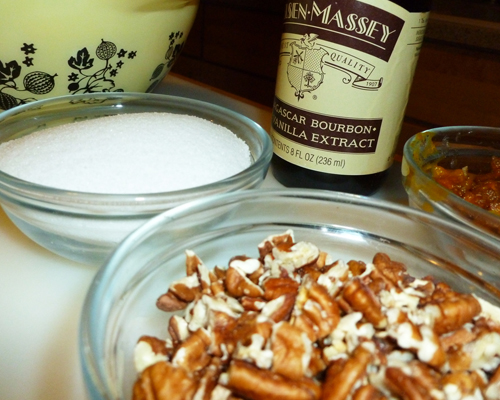
Pumpkin/Pecan Biscotti
Ingredients
2-1/4 c (282g) all purpose flour
1-1/2 tsp. baking powder
2 tsp Pumpkin Pie Spice
1/2 tsp salt--reduce to 0 to 1/4 tsp if you substitute salted butter
¼ tsp Freshly grated Nutmeg
1/2 c (114g) unsalted butter
2/3 c (134g) granulated sugar
1 large egg (50g)
1/3 cup cooked, pumpkin puree (~80g)
1 tsp. vanilla
½ cup roasted pecans
½ cup diced (3/16”) candied pumpkin. Note: Cook on medium-low heat only until just tender, not mushy; about 5 minutes.
Directions
Pre-heat oven to 350°F. Do not use a baking stone, nor leave one in the oven. The oven needs to cool quickly for the second baking. The heat stored in some baking stones will prevent that.
Combine flour, baking powder, spices and salt; whisk to distribute evenly.
Cream the butter and sugar until homogeneous. Add egg, pumpkin puree and vanilla and beat together.
Combine the dry ingredients with the wet, and either by hand or on lowest mixer setting fold or beat them until they are just combined.
By hand, using a rubber spatula, fold in nuts and diced pumpkin gently until evenly distributed.
The dough should be stiff, but will still be sticky.
On half-sheet pan or cookie sheet, lined with parchment paper or a fiberglass pad, form two trapezoids.
Bake until top center of the loaves spring back to a light touch, or a toothpick come out cleanly. (usually 16 to 22 mins.)
Remove from oven, let cool on pan for 10 mins. Reduce oven temperature to 300°F.
When cooled, carefully remove one loaf to a cutting board--I use an eight-inch wide cake-transfer spatula. There is a danger of the loaves breaking in half from their own weight unless you support both ends.
Using a serrated blade cut 3/4" inch thick slices, on a bias and return them to the baking pan, one cut side down. Do the same with the second loaf.
Bake for 20 minutes at 300°F, test for crispness--the up side should be very firm, a slight spring is ok. Remove the pan from the oven, and flip each cookie exposing the original down side. Bake another 20 minutes or until the up side is crisp (no spring) and dry. Remove and cool for 5 minutes on the pan, then transfer to a cooling rack.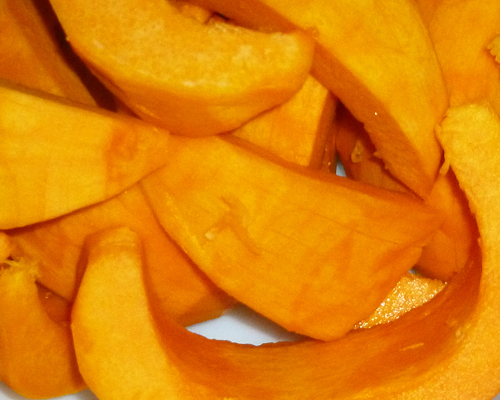
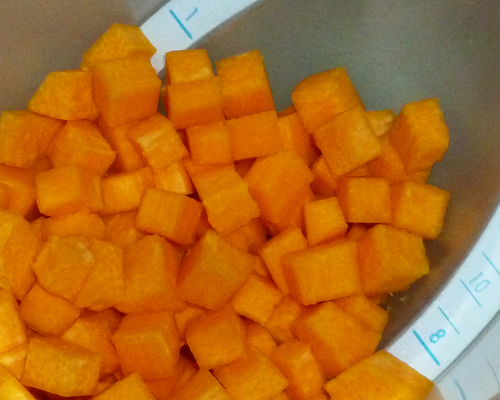

Candied Pumpkin
Ingredients
- 4 tablespoons unsalted butter
- 3 cups diced (1/2 inch) sugar pumpkin or butternut squash
- 1/3 cup sugar
- 3/4 cup maple syrup
- 1 tablespoon minced fresh ginger
- 1/2 teaspoon cinnamon
Directions
- Melt the butter in a large heavy skillet. Add the pumpkin and cook over moderately low heat, stirring occasionally, until tender, about 20 minutes. Stir in the sugar until dissolved. Stir in the maple syrup, ginger and cinnamon and remove from the heat. Let cool and refrigerate until chilled, at least 2 hours or overnight.
Recipe compliments of FoodandWine.com
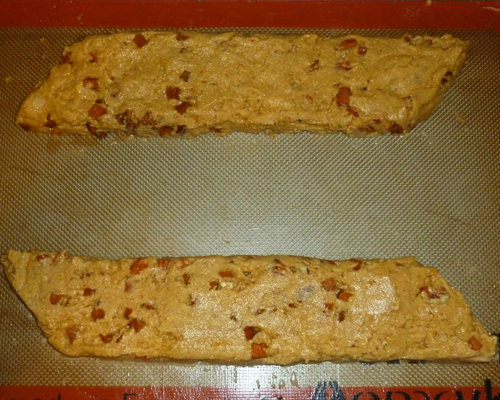
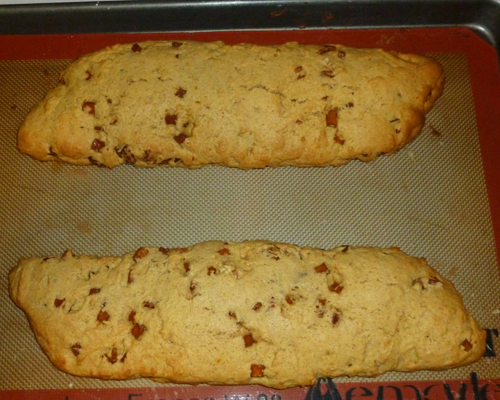
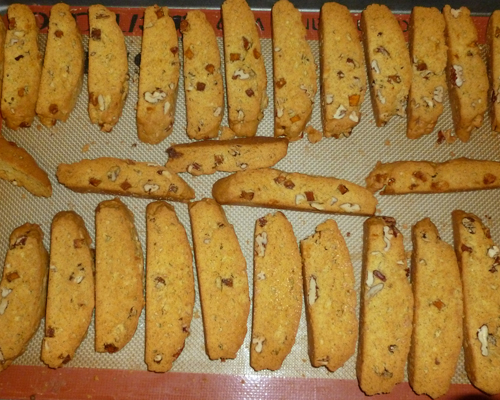
Notes:
I only had one small Pumpkin Pie pumpkin (about 3 lb.) so I only candied 1 cup of diced pumpkin. The biscotti recipe is simply my usual biscotti recipe with a couple of tweaks. I reduced the sugar slightly (3/4 c to 2/3 c) to account for the sugars in the candied bits. In actuality, I don't think it made much difference, if at all. I also eliminated 1 egg, relying on the water in the pumpkin puree to replace the egg's moisture contribution. I also added 1/4 c of AP flour, expecting the puree to be wetter than one egg. It was, the additional flour was needed.
For a first try, I'm pleased. Their flavor isn't "in your face", but neither is it subtle. I found myself liking the taste better with each nibble: a nice way to experience any flavor.
The first baked loaves were more fragile than usually experienced. I think in my next effort--there will be one--I'll restore the second egg, and wring some of the water out of the pumpkin puree. The second egg should improve the dough's cohesiveness, and contribute to a richer flavor.
I was concerned that perhaps I'd over-cooked the diced bits of pumkin, and that they would turn to mush when folded into the dough with the pecan. To guard against this I spread the bits on a plate, and froze them. Frozen solid, they mixed in beautifully.
My wife wants me to add more candied bits. I will.
Happy Hollowe'en
David G